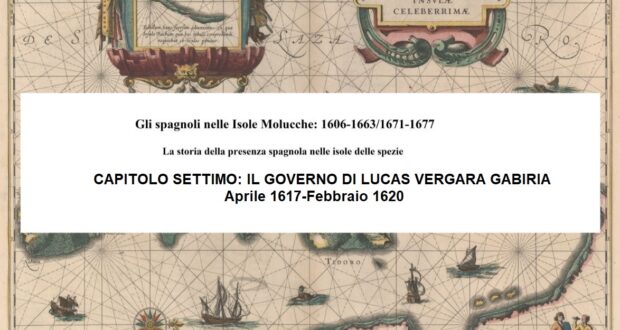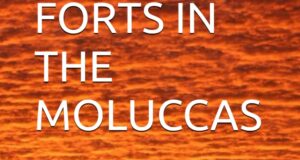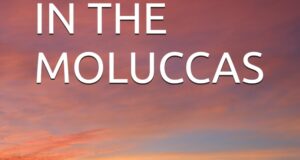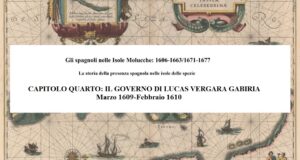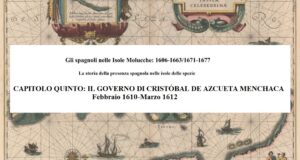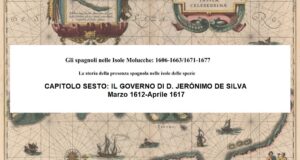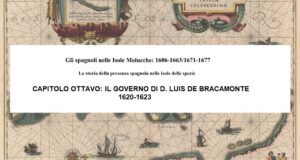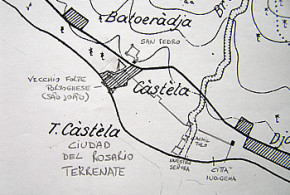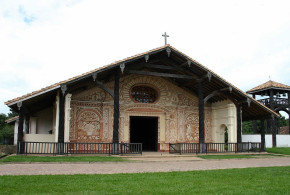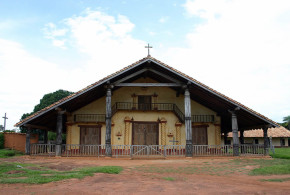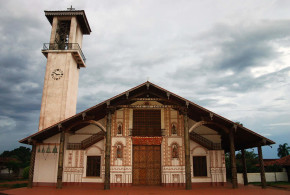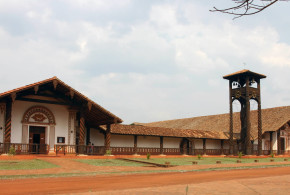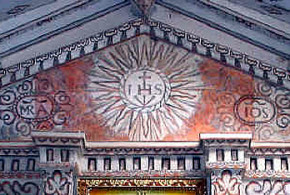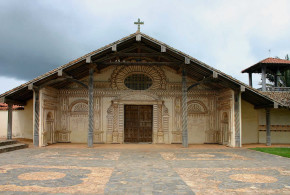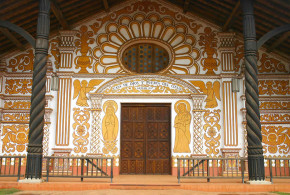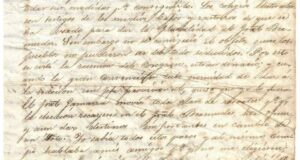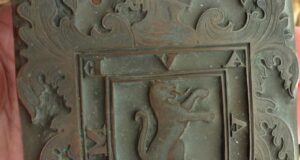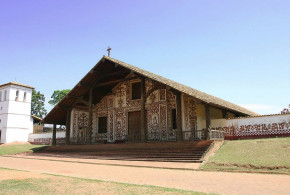This post is also available in:
![]() Italiano
Italiano
The Spaniards in the Moluccas: 1606-1663/1671-1677. The history of the Spanish presence in the spice islands
Written by Marco Ramerini. 2005-2020/23
CHAPTER SEVEN: THE GOVERNMENT OF LUCAS VERGARA GABIRIA, April 1617-February 1620
THE ARRIVAL OF LUCAS VERGARA GABIRIA IN TERNATE
In April 1617 a galley was sent from Manila to warn Don Jeronimo of the new events1 and to inform him of the need for his presence in Manila. The sent galley was loaded with provisions and material for the garrisons, in fact there were 10,000 pesos, 4,500 pieces of cloth, a good quantity of rice and wine as well as a few jars of gunpowder. Perhaps reference is made to this in the document Meritos of Juan de Acevedo when it speaks that in 1617, Juan de Azevedo was in charge of the rescue that was sent to Ternate consisting of a single ship. 2
Twenty days later three “pataches” were also sent, they carried more than 3,000 baskets of rice, with wine and meat, a quantity of clothes, 6,000 pesos, 4 pieces of 18 (pieces of artillery), several jars of gunpowder, cannonballs, and several other things necessary for the forts. This new shipment of material is described in Moluccas documents as the largest shipment of aid and material for several years. The new governor of Ternate Lucas de Vergara Gabiria also embarked with these ships. He was a veteran of the Moluccas, who had already served as governor of the islands for about a year (see chapter 4). 3
Vergara Gabiria arrived in Ternate on 26 April 1617 with three boats that brought reinforcements for the garrisons of the islands. With him came 30 soldiers. The new governor immediately took care of the conditions of the troops, giving them clothes and pay, these attentions of Vergara Gabiria towards the soldiers of the garrisons led the Jesuit Manuel Ribeiro to declare in one of his letters that the new governor “el año pasado con su ida a Terrenate resucitó aquella tierra” 4 The new governor of Ternate was considered a good soldier but with a severe disposition. 5
SPANISH EXPEDITION TO CELEBES (SULAWESI)
The new governor immediately tried to mitigate the chronic problem of food supplies. In order to secure the influx of provisions from the island of Celebes, the Spaniards decided to build a fortress in Manados, for this purpose an expedition made up of 10 soldiers was probably sent in May 1617 by Vergara Gaviria under the orders of Francisco Melendez and two Jesuits (the two Jesuits were Gianbattista Scalamonti and Cosme Pinto). The Spanish built a small fortified post. 6 In 1618 the Spaniards established cordial relations with the king of Macasar (Manado ?). 7 Good successes are had in the evangelization of the kingdom of Manados (northern area of the island of Sulawesi-Celebes), the king and almost all the princes are converted, Father Cosme Prieto takes care of this mission.
THE DUTCH IN DIFFICULTY, BUT THE SPANIARDS DOESN’T TAKE ADVANTAGE OF IT
During 1617 and 1618, the Dutch are faced with various revolts in the Moluccas and other islands of the archipelago. They managed to quell a revolt in the bud on Machian Island, by hanging the rebel leader, but in other islands they failed to anticipate events. On the island of Siao, the local population had revolted killing all the Dutch present with the exception of three men who they handed over to the Spanish governor of the Moluccas for service in the galleys.
There were also revolts in the Banda islands and in Ambon. The Dutch then also had to face the threat posed by the British, who established a fort on the Banda Islands. According to Governor Gaviria, if the Spaniards could have sent a large army to the Moluccas during this period of revolt in the other islands, the Dutch would perhaps have been expelled definitively from Ternate. 8
In October 1617, Spanish documents mention a fire that spread rapidly from a bastion of the Dutch fortress of Malayo to the whole city, destroying the houses and warehouses of the settlement. 9
THE SITUATION OF THE DUTCH IN THE MOLUCCAS
A Spanish document from 1618, probably drawn up by Pedro de Heredia, informs us of the situation of the Dutch possessions in the Moluccas. Much of the information cited in the Spanish document is the result of information obtained from the Dutch admiral van Caerden who had been a prisoner of the Spaniards in Ternate for some time.10
The situation of the Dutch possessions in the Moluccas in these years is as follows: In the island of Bachan they have a fortress. While in the most important clove-rich Maquian Island, the Dutch control the entire island with three fortresses. In Mutiel Island they have a fortress. The island of Tidore is largely under Spanish control, but the Dutch have a fortress along the west coast (while the Spanish have a fortress on the east coast). The island of Ternate is divided between the two powers. The Dutch control the east and north of the island and have their main base here at Fort Orange and another fort in the north of the island. The Spanish have their fortified city in the south of the island. But most importantly, the Dutch hold much of the archipelago’s clove and other spice trade.11
The Dutch governor lives on the island of Ternate, he resides in the fort of Malayo, called by the Dutch Granoya (probably a distortion for Fort Oranje). The garrison of the fort is normally composed of 850 soldiers (but in the period described there are only 150). A quarter of a league from Malayo is the fort of Toloco (Tolokko) in which resides a garrison consisting of an ensign and 20 soldiers. Another fort called Tacubo, is located in the vicinity of Malayo. The fort of Tacome located three leagues from Toloco is a large fort and is garrisoned by a company of soldiers, this fort is called by the Dutch Vuillemistat (Willemstadt).
On the island of Tidore the Dutch had never had a fortress since the time of the Acuña expedition. Then in early 1613 they captured a small bastion where the Spanish held a garrison of an ensign and 14 soldiers. Here the Dutch built the fort of Marieco the Great, which was manned by a captain and 60 soldiers.
On the island of Moti, which is located between Tidore and Maquien, the Dutch have a fort (Fort Nassau) located in the northern part with a garrison of 50 soldiers commanded by a captain. The island was depopulated, but was repopulated by inhabitants of the island of Gilolo.
The island of Maquian, the most important from a commercial point of view, located one league from Motir has three Dutch forts: Nofagia (Ngofakiaha), located in the north of the island has a garrison of an ensign and 40 married soldiers. Tafazen (Tafasoho), on the west coast, with a garrison of 100 soldiers commanded by a lieutenant governor. While on the south coast was the third fort called Tabelole (Tabelolo), a small fort of little importance with a sergeant and 20 soldiers.
In Bachian Island the Dutch have a fort called Bernevelt (Barneveld) with a captain and 60 soldiers. In the island of Gilolo, about three leagues from the fort that the Spaniards have on this island, the Dutch have the fort of Tabori with an ensign and 50 soldiers. Three leagues further on is another fort with a lieutenant and 12 soldiers.
On the island of Amboino, also very important for the production of cloves, the Dutch have another large fort with a large moat. Its garrison consists of a commander and 100 soldiers. On the island of Siao in 1614 the Spaniards had a garrison of an ensign with 5 soldiers, they were attacked by the Dutch who, after defeating them, built in the same place, called Sagu Maruco, a small fort in which resides a sergeant and 16 soldiers. In the Banda Islands the Dutch have two forts called Moçovia and Belgium each with a garrison of 120 soldiers.
In the island of Java they have three farms in Bantan, Jacava and Japara. Bantan is the main Dutch settlement in all of the East, the governor of the company resides here, the Dutch have a force here consisting of two galleys, thirty armed “barks” which they use to travel to Jakatra, a place located at one day of travel, where is the Dutch arsenal and shipyard. Other Dutch forts or farms are in the island of Formosa, Cambodia, Sumatra, Japan, Cochinchina etc….
According to a report by Joris Spilberg, in 1616 the Dutch had in their forts in the east about 3,000 regular soldiers, 193 bronze pieces, 310 iron cannons, 300 swivel cannons, 30 war galleons in addition to the galleons that arrive every year from Holland.
The Dutch obtain the following quantities of cloves annually from the Moluccas12:
Ternate 600 bares or 384,000 pounds of cloves.
Motir 700 bares or 468,000 pounds.
Maquiem 1,400 bares or 896,000 pounds.
Bachian 400 bares or 256,000 pounds.
Amboyno 1,800 bares or 1,152,000 pounds.
SKIRMISHES BETWEEN SPANISH AND DUTCH
In late 1617 there were some minor skirmishes between the Spanish and the Dutch. The rapprochement of relations between Tidore and the Dutch was cooled, fortunately for the Spanish, due to the behavior of the Dutch, who hanged a Tidorese and drowned 4 of them. This action led the prince, son of the king of Tidore, who until that moment he had been very friendly with the Dutch, completely reviewing his own positions. In another clash 4 Spaniards were killed. The Spaniards in December 1617 led by Captain Salinas attacked Takome in retaliation where they managed to capture two “champanes” loaded with rice. Alonso Martin Quirante, “castellano de la fortaleza de Tamarina”13 he killed 21 Dutch in an ambush and captured 4.14 There were also many deserters who went over to the Spanish, including 25 Dutch and many Indians. 15
VERGARA IMPROVES SPANISH FORTIFICATIONS
The new Spanish governor immediately devoted himself to the maintenance and improvement of the forts in Spanish hands on the islands of Ternate, Tidore and Halmahera (Gilolo, Tafongo and Payagi), a work which he completed with excellent results. In fact, those fortifications that were still made of wood and earth were rebuilt in solid stone, says the Jesuit Ribeiro: “no ay al presente caballero ninguno en Maluco que no sea de cal y canto”.
The stronghold of Socanora in Tidore was fortified, which was located in a very strategic point, and which had repeatedly been attacked by the Dutch. The two cities of Ternate and Tidore were also surrounded by solid walls. A weak point of the Spanish defenses in the islands was the lack of long-range cannons, which would have allowed, if placed in the forts of Tomanira, Don Gil and Tidore, to control the passage of enemy ships in the three channels used by Dutch vessels to reach the their fortress of Ternate (Malayo).
The Spanish troops then complained of the shortage of food and clothing and had been waiting for the pay to arrive for some years. An annual replacement of a couple of companies of soldiers is also suggested, and the sending of better selected captains is requested as well as the importance of having at least one galley in charge of the islands. 16 Even the king of Tidore is fortifying his city as best he can. 17 The governor of the Philippines Fajardo, following the requests that reach him from Ternate, expresses his intention to send a couple of galleys with the next relief supplies destined for Ternate. 18
In January 1618 several small boats were sent from Ternate to Jilolo with a galliot to supply the Spanish garrison with food, the Dutch and the inhabitants of Sabugo attempted to intercept the convoy, but failed in the enterprise, losing in the skirmish 8 dead and several wounded. 19
Luckily for the Spaniards, supplies arrived from other routes, in fact towards the middle of 1618, an English boat arrived in Tidore where it exchanged munitions and rice with the Spaniards in exchange for cloves, furthermore the viceroy sent 6 “galeotas” from India laden with provisions. 20
Vergara established a farm in Ternate where to conserve cloves. 21 This was done to try to bring some income to the royal coffers, given that the occupation of the Moluccas costs the royal treasury 220,000 pesos annually and does not bring any economic benefit, while on the other hand the Dutch receive immense gains from the spice trade. The king asked the governor of the Philippines Fajardo to also consider reducing the number of soldiers stationed on the islands, which amount to 600 Spanish soldiers and 200 pampangos and finally to abandon all the forts deemed unnecessary. 22
On March 5, 1618, the Ternate volcano began to erupt, one day it erupted three times, and this lasted for eight/ten days. 23
THE RESCUE OF 1618
The aid sent from Manila in 1618 all arrived at their destination, they consisted of (5 ?) ships loaded with provisions and money for 15,000 pesos for troop wages. However, there is still a shortage in the number of soldiers, many of them being ill and several having died from illnesses. 24
The “socorro” for the Moluccas that reached Ternate in the middle of March 1618 was made up of 4 boats, the Spanish ships were attacked by two Dutch ships in sight of Ternate, at the first attempt the Spanish boats managed to escape, but after a few days, when the Spanish again tried to reach the port of Ternate, they were again attacked by the Dutch, and this time forced to give battle.
The Spanish managed to break the Dutch naval blockade, but one of the ships, the ship almiranta captained by sergeant major Pedro de Cuenca, ran aground on the coast of the island of Tidore. Most of the crew made it to safety, but some drowned and others were killed by the Dutch. The captain of the fort of Tidore, Alonso Martin Quirante, arrived in a hurry and managed to prevent the Dutch from picking up part of the ship’s cargo, however much of the cargo was lost. The loss of this vessel was attributed to the lack of galleys. The other three ships managed to arrive safely in the port of Ternate. With this relief came two companies totaling 46 soldiers. 25
In a letter dated June 30, 1618, the governor reiterated the shortage of soldiers and supplies, informing us that in 1617 the only soldiers received were the 30 who arrived with him, while in 1618 two companies arrived for a total of 46 soldiers, just as many sick soldiers were sent back to Manila.
THE SPANISH LACKS GALLEYS, CLOTHES AND FOOD, BUT THE DUTCH HAVE PROBLEMS TOO
Vergara succeeds with the few means he has at his disposal to considerably improve the situation of his troops and fortifications, but he complains of the lack of galleys, in fact he only has one galliot in bad condition (“marcia”). Many provisions are received from the island of Celebes, which proves to be an excellent source of supply. The necessity and importance of the galleys is reiterated several times in many letters even in the following years by many captains, they are an excellent tool for maintaining contacts between the various garrisons located on several different islands and are also an excellent means of attacking the enemies, even the king of Tidore insistently asks for them to be sent. Another shortage often denounced by the captains of Ternate is that of clothes for the soldiers.
An interesting reference is made in the same letter to the situation of the Dutch, which is seen in a different way compared to the past, in fact Vergara informs us that they too have a shortage of soldiers and do not expect important arrivals as in the past, furthermore there are also some problems with indigenous people who appear to be in rebellion. Vergara identifies in the English, increasingly strong and present in those seas, a possible excellent support and ally for the Spanish. He also spoke of this with the captain of the English ship present in Tidore. 26
VERGARA ASKS TO WITHDRAW PART OF THE GARRISONS FROM HALMAHERA
The three Spanish presidios located on the island of Halmahera (Batachina), namely Gilolo, Tafongo and Payagi, are of great tribulation, because due to the unhealthiness of the places many soldiers fall ill and die. 27
Vergara requests permission to withdraw the Spanish garrisons from the two forts of Jailolo, which have a total garrison of 80 men including 60 Spaniards. This is required in order to increase the strength of the Ternate and Tidore garrisons. In his letter, he asked for a decision to be made regarding the garrison of Jailolo which in his opinion was useless: “Las dos fortalezas q.e su Mag.d tiene en Jilolo como Vs.A sabe no sieruen sino de tener alli ocupados ochenta soldados los sesenta españoles y cada dia ttraen muertos y enfermos …”. Already in 1618, Gaviria asked the governor of the Philippines, Alonso Fajardo de Tenza, for a decision on this matter. 28
THE SPANISH FORTS IN THE MOLUCCAS IN 1618
An interesting description of the Spanish and Dutch forts of Ternate and Tidore is given to us by an anonymous report written in Malacca at the end of 1619, which describes the Spanish forts and garrisons in the Moluccas around 1618. 29
The Spanish city of Ternate (“do Rossario”) has a Spanish garrison of three hundred casados and soldiers. The city is all walled with six bulwarks that the Spanish call “cavaleiros” which have 20 very good bronze artillery pieces. Outside the walls there are other bulwarks to defend the native quarter where about 150 Pampagos soldiers and more than 100 native Christian men of Ternate live, in total the population of the city between men and women reaches 2,000 units, all Christians. The city has 4 churches, one is the “matrix” church where a “vigairo da vara” resides, the others are the convents of the Franciscans, the Jesuits and the Augustinians. 30 At the end of 1618, the Jesuit Francisco de Otazo estimated the Christians of the Moluccas at 160,000. Certainly an exaggerated figure.31
The city also has a hospital. It is always the Franciscans who take care of the care of the sick and wounded, in fact the lay friar Juan de Santa Maria takes care of the hospital. A surgeon sent by the governor of the Philippines to take care of the hospital is returned to the sender by Vergara because he was deemed unsuitable for the need. 32
To complete the defensive system, the Spanish have another fort called Dom Gil, it is located about half a league from the Dutch fortifications and has a garrison of 60 soldiers with their captain, the fort has three bulwarks with 4 artillery pieces. The fort is located near a lagoon, which is located near the sea and which is deep enough to allow boats to navigate, it seems that the Portuguese in the past had tried to join the lagoon to the sea with a canal so as to be able to use the lagoon as a port for their boats, but they did not complete the enterprise. 33
The main Dutch fortress is that of Malaio, it is described as so well fortified as to frighten those who see it (“esta em demasia fortificada e fortalezida que mete pavor e espanto a quem a ve”), it has three bulwarks, the first is called “Orange” and has 17 very large bronze artillery pieces, next to this is another bulwark called “Ponta Real”, it has 10 artillery pieces, while the third bulwark has 8 artillery pieces. The garrison consists of 200 Dutch, 150 Japanese and 200 Chinese. Next to Malaio is another Dutch fort, it is called Tonloco, it has a bulwark and its garrison is made up of 20 soldiers with 4 artillery pieces. The Dutch have another fort, called Tacome, closer to the Spanish city of Ternate, the garrison of this fort consists of 30 soldiers with 6 large artillery pieces. It controls the passage of Spanish ships bound for Ternate and is very annoying for the Spaniards also because it is the base of some boats used by the Dutch to hinder the arrival of aid convoys in Ternate. 34
In the island of Tidore the Dutch have a fort in Marisco, which they call “Marisco dos Portuguses”, they conquered it by killing 50 men. 35 The Dutch fort has three bulwarks (“baluartes fechados”) with 17 artillery pieces including a very large one called “o Raymundo”. The fort is normally garrisoned by 60 men, the “roda” of the fort is then a wooden palisade inside which there are the homes of the natives and the “gente de serviço”. The Spanish have near this Dutch fort, another fort. 36
The Spanish have another fort, called Tomarina, it is located on a hill (“por estar situada em hum alto”) and is defended by 3 pieces of artillery and by a garrison made up of 40 Spaniards and more than 300 Tidorese with muskets and swords. In the island of Tidore the Spaniards also possess a small city (“cidade pequena”) where mostly Portuguese casados live, near this city there is the largest fortress in Spanish hands on the island, called Thaula, it is located on a hill (“estar muito alta”) in an impregnable place, it has a garrison of 40 soldiers commanded by a captain and is armed with 10 pieces of artillery. Furthermore, always in the vicinity of this fortress, the Spaniards have a bulwark, called “Principe”, armed with 3 artillery pieces and where 10 soldiers are stationed with their ensign. 37
Opposite the Spanish fortress of Thaula, the king of Tidore, an ally of the Spanish, has his own fortress, also located on a hill (“esta no alto”) and armed with three pieces “de escolher” and 10-12 “falcões”. The troops available to the king of Tidore include 2,000 musketeers and 2,000 “campilão carrasca” fighters. Finally, on the island of Tidore the Spaniards have a church where a “clerigo vigairo” lives and another “casinha” where a religious of the company (Jesuit) says mass. This report also makes a small mention of the fortress that the Dutch have on the island of Moutiel, it has 20 artillery pieces and 70 garrison soldiers. 38
THE DUTCH FORTRESSES IN THE MOLUCCAS
More or less of the same period (around 1620) is a more succinct report on Dutch and English fortresses and farms, in which the number of fortresses present on each island is described with the respective garrisons and armaments, but the names of the fortresses are not mentioned.
On the Moluccas (the part that interests us is that which is currently part of the province of North Maluku) the following data are listed: On the island of Ternate the Dutch have 4 fortresses, one with 32 artillery pieces and 200 Dutch soldiers, another with 8 pieces and 70 Dutch, another with 9 pieces and 20 Dutch, and finally the fourth with 3 artillery pieces and 20 Dutch. On the same island the Spaniards have 4 fortresses, the most important has 24 pieces of artillery and 80 Spanish soldiers, the second has 3 pieces and 30 soldiers, the other two both have 4 pieces and 20 soldiers. A note adds that the Dutch own most of the island and also own the best part.
On the island of Tidore the Dutch have a fortress with 17 artillery pieces and a garrison of 60 men. The Spanish have 3 fortresses and control most of the island. On the island of Motiel the Dutch have a fortress with 12 artillery pieces and 60 soldiers. The whole island is in their possession. In Maquien Island there are three Dutch fortresses, one with 20 pieces and 80 soldiers, another with 12 pieces and 90 soldiers, the third one with 7 pieces and 29 soldiers, this whole island is also completely controlled by the Dutch. On Bachian Island the Dutch have a fort with 16 artillery pieces and 60 Dutch. Finally, the island of Halmahera (Batachina) where the Dutch have two fortresses with 8 pieces and 60 Dutch and 9 pieces and 29 Dutch respectively, and also have garrison soldiers in two places where they get food for their troops. 39
THE CONSTRUCTION OF THE RUME FORT AT TIDORE
The fort of Rume was built following a letter from the king of Tidore sent to the governor Vergara and delivered to the same governor by the prince of Tidore Cachil Naro, in which the king asked the Spaniards to build a Spanish fortress in a place where the Portuguese had already established themselves, near the Dutch fort of Marisco (Marieko), in order to surround the Dutch and prevent them from harvesting the cloves which were produced in abundance in that area of the island.
Vergara at the head of 150 Spaniards and many Indian soldiers and accompanied by Cachil Naro and two Franciscans, Br. Pedro de los Cobos and Br. Gregorio de S. Esteban, on November 23, 1618, founded the fort of S. Lucas de el Rume, the fort was built on a high place, where Dutch artillery shots could not reach. In fact, during the construction of the fort, the Dutch attempted an attack, which however did not have any practical results. The fort was named S. Lucas in honor of the governor who had founded it: Lucas de Vergara Gabiria. 40
THE CONSTRUCTION OF THE FORT OF SANTA LUCIA IN TERNATE
As a countermove to the construction of the Rume fort, the Dutch decided in December 1618 to build a fort in Calomata, it seems also at the request of the Ternatese, the position chosen was close to the Spanish fort of Don Gil (“como medio quarto de legua y mucho menos”) and was of great inconvenience to the Spanish fort especially if the Dutch, in addition to building the fort as they did, also occupied a nearby hill above the Spanish fort. To avoid this, Vergara decided to anticipate the Dutch by building a stone fort with a moat and fence on the hill. The works for the construction of this fort began on December 13, 1618 and since this day is dedicated to Santa Lucia, the new fort was called Santa Lucia. 41
Further information on this episode is provided to us by another document, it informs us that the captain and sergeant major Antonio Carreño de Valdes together with the captain Juan de la Umbria, while they were building the fort of Santa Lucia, went together with a troop of 50 Spanish troops, “a rreconoscer las fuerzas de Calomata”, which the Dutch were building, having been seen by the Dutch, the Spanish troops had a clash with the enemies, in the clash Captain Juan de la Umbria was wounded by a musket shot in the right arm. 42
THE DESCRIPTION OF FR. GREGORIO DE SAN. ESTEBAN
Fr. Gregorio de S. Esteban leaves us an interesting description of the Spanish and Dutch forts present in recent years in front of the stretch of sea between the islands of Ternate and Tidore: “Es Terrenate un volcan redondo; el pueblo y ciudad de Terrenate está á la banda de el sur, Tacome á la banda del norte, Malayo á la banda del este, y costeando hacia el sur, está el puerto que llaman de Talangamé, y un poco más adelante está el puerto que tratamos de Calomata, y un poco más adelante nuestra fuerza de Dongil.”
“De la otra banda está la isla de Tidore, que tambien es un volcan redondo y alto, pero tiene hacia la parte del norte, que cae hacia Malayo, una grande falda con unos mogotes grandes, y enesta parte está nuestro fuerte de S. Lucas, suerte que están mirando S. Lucas y Calomata, pero está la mar en medio, y es la travesia de una isla á otra, la más corta, un tiro de cañon, aunque las fuerzas están muy desviadas. Junto á la isla de Tidore y cerca de S. Lucas está otra isla pequeña, que se llama Meytara, de suerte que está en medio de Tidore y de Terrenate, pero mas llegada á la isla de Tidore que de Terrenate, y así hace dos brazos de mar, el uno más estrecho que el otro, fondeables; el uno le guarda nuestra fuerza de Dongil y el otro le guarda el fuerte de S. Lucas; pues para estorbar nuestras embarcaciones que no fuesen á S. Lucas, tomaron el puerto de Calomata, que tambien alcanza con su artilleria á la isla de Meytara. El otro brazo de hacia Tidore, tambien lo guarda la fuerza de Marisco que está alli junto” 43
COMPLAINTS ABOUT THE SPANISH GOVERNORS OF THE MOLUCCAS
The son of the King of Tidore for years in sharp contrast with the Spanish governors who have succeeded, in particular with Gerónimo de Silva, expresses to the King of Spain his opinion regarding the behavior of the Spanish governors of Ternate, informing him that things in the Moluccas they go very differently from what the King orders and that the governors practically do what they want without bothering to respect the orders of the King of Spain.
He also adds a veiled threat, saying that if things continue like this there will be the risk of losing the Moluccas because “Dios concierte, mas no para siempre”. However, the loyalty of his father and of him to the Spanish crown is reaffirmed. The letter, most likely written in secret, is entrusted to a certain Juan de Aillón, who was a soldier in the Moluccas from 1615 to 1618. He will have to report to the King, according to the intentions of the Prince, the misdeeds of the Spanish governors. 44
Strong complaints also reach Governor Fajardo from both lawmen and religious about the behavior of Lucas Vergara, he is accused of harshness in government and lack of balance in many situations. The Jesuit Manuel Ribeyro, in his letter dated August 10, 1618, expresses a completely different opinion towards Vergara, judges him a great servant of the King and expresses the opinion that with his coming to Ternate he resurrected those “presidios”.
Even the governor Fajardo does not believe these accusations, to remove the chestnuts from the fire to Fajardo, comes a letter from Vergara in which he resigns from office. In his place D. Jeronimo de Silva was initially appointed, who however refused the assignment, and finally D. Luis de Bracamonte was appointed. 45
During his rule Vergara seems to have often resided in Tidore, in fact several of the letters he sent were written in Tidore. The task of governing Ternate in his absence had been entrusted to Captain Juan de la Umbria. 46
Fajardo in December 1618, in describing the assignments and expenses that he judges superfluous and to be cut to better rationalize the meager budget he has available, indicates the excessive number of 600 Spanish soldiers and 200 panpangos stationed in the garrisons of the Moluccas, deeming a cut in the number of soldiers stationed there desirable. 47
The Dutch continue to send fleets and soldiers to the islands. Then, as we have seen, they built a new fort on the island of Ternate (Calomata). On the other hand, the Spaniards also built another fort on the island of Tidore (Rum) and are building another one (Santa Lucia in Ternate). 48 On February 4, 1619, 4 frigates loaded with food and materials for the “presidios” of Ternate left the Philippines, the ships arrived in Ternate without encountering enemy ships.
LETTER FROM VERGARA GAVIRIA ON THE SPANISH “PRESIDIOS”
In May 1619, the governor of Ternate, Lucas de Vergara Gaviria in a letter to the King of Spain 49 points out the big problems that the Spanish forces have in the face of the excessive power of means of the Dutch. Vergara once again complains about the scarcity of help that reached him, in fact in the three years of his government the misery of 80 soldiers without any galley had arrived, while in past years generally 150-200 soldiers and one or two galleys arrived every year, this situation is unsustainable and is aggravated by the fact that over 200 soldiers have died of disease or war in the past three years.
With the few soldiers he has at his disposal, he must garrison 10 fortresses (three located on the island of Ternate: Terrenate, San Pedro and Don Jil; three in Tidore: Tohula, Tomanira and Sokanora; three in Halmahera: Jailolo, Tafongo and Payaye; and one in the island of Sulawesi (Celebes): Manado) and was forced in the last year to build two more, one in Ternate (Santa Lucia) and another in Tidore (San Lucas de el Rume), because the Dutch had planned to occupy it, being these two places “puestos de tanta considerazion”. 50
The fortresses in Spanish hands, Vergara informs us, have a third of the garrison they normally should have. Governor Fajardo had promised to send reinforcements as soon as possible. If these reinforcements do not arrive as soon as possible, Vergara believes he will be forced to abandon some of the garrisons, furthermore rumors have reached Ternate of the imminent arrival of two large fleets, one Dutch and one English and this would contribute considerably to aggravate the precarious position of the Spaniards.
There are 6 companies of Spanish infantry and 2 of pampanga infantry, all these companies have very few soldiers, there are also Indians who serve as “gastadores” and in other duties. In addition to the small number of soldiers present, most of them are ill (“no ay nenguno en pie”) with a disease that Vergara defines as “un mal pestilençial”. Furthermore, the troops are never regularly paid and this is often a source of discontent among the soldiers and none of them is happy to be serving in Ternate “no ay honbre que no desea salir destas yslas”. In order to solve the problem presented by the Dutch in the Moluccas, according to Vergara, it would be necessary for the King of Spain to send a large expedition which, combined with the forces present in the Philippines, would destroy once and for all the Dutch forces present “limpie esto destos corsarios”. 51
Vergara, who has been serving the King for 36 years now, informs us that he has asked the governor of the Philippines to resign from his post as governor of the Moluccas, because he feels very tired and infirm and unable to continue serving in this assignment. Vergara also makes an interesting suggestion regarding the power that the governor of the Moluccas should have, in fact he suggests that the governor should have the title of captain general with the faculty of appointing positions and promotions, without it being the governor of the Philippines to do this, says Vergara to encourage soldiers to serve in the best possible way because having someone on the spot who can see and reward heroic deeds stimulates others to do the same. 52
Vergara informs the King of Spain that there are four islands where cloves are produced: Ternate, Tidore, Motiel and Maquien. The total annual production of these four islands is estimated at 15,000 quintals of cloves. Furthermore, in the island of Ambon, Vergara estimates, a similar quantity of cloves is produced. Of all this production, only a small part, 2,500 quintals, is traded by the Spaniards, all the rest of the production is traded by the Dutch, they then control all the nutmeg trade which is produced in the Banda Islands. This trade allows the Dutch to support the war against Spain and to arm and sustain the magnificent fleets that they send every year to the waters of the Moluccas. Vergara estimates that with the revenues of a single year of the production of these islands, the King of Spain could arm a huge fleet with which to drive the Dutch out of these waters once and for all. 53
In the Spanish archives there should exist another report of the Spanish and Dutch forts in the Moluccas written during these years by the captain and sergeant major Alonso Martin Quirante. 54
INDEX
1: The first contacts of the Spaniards with the Moluccas
2: The conquest of Ternate
3: The government of Juan de Esquivel, May 1606-March 1609
4: The government of Lucas de Vergara Gabiria (acting the functions), March 1609-February 1610
5: The government of Cristóbal de Azcueta Menchaca (who performs the duties), February 1610-March 1612
6: The government of D. Jerónimo de Silva, March 1612-April 1617
7: The government of Lucas de Vergara (Bergara) Gabiria (second term), April 1617-February 1620
8: The government of D. Luis de Bracamonte (who performs the functions), February 1620-1623
9: The government of Pedro de Heredia, 1623-1636
10: The government of D. Pedro Muñoz de Carmona y Mendiola (who performs the functions), March (?) 1636-January 1640
11: The last Spanish governors of the Moluccas
12: Bibliography
NOTES:
1 In April 1617, the Dutch were soundly defeated by the Spanish in the famous naval battle of Playa Honda. (Pastells “Historia general de Filipinas” Tomo VI (1608-1618) pp. cccxcii-)
2 (AGI: “Meritos, Juan de Acevedo 1625” Indiferente,111,N.56)
3 (Lettera di Licentiate Andres de Alcaraz al re Felipe III, 10 agosto 1617; in Blair vol. 18 pp. 42-45)
4 (Doc. Mal. III p. 378 Lettera di Manuel Ribeiro a Alonso Fajardo de Tenza, Cavite 10 agosto 1618) (Rios Coronel, Hernando de los “Memorial y relacion…” 1621, Madrid, Spain. In: Blair, E. H. e Robertson, J. A. “The Philippine Islands, 1493-1898” vol. 19 (1620-1621), p. 274, Lettera di Lucas Vergara Gaviria a D. Francisco Gomes de Arellano, 5 luglio 1617) (Letter from Fajardo to King Felipe III, 10 August 1618 in Blair vol. 18 p. 143 where the letter from Governor Vergara dated 30 June 1618 is reported) (AGI “Copia de carta de Lucas de Vergara Gaviria, gobernador de Terrenate, al gobernador de Filipinas, sobre las dificultades que encuentra para la compra de clavo; las conversaciones con el rey de Tidore que le comunicó que los naturales de Vanda junto con los ingleses habían dado ponzoña a los holandeses causando muchos muertos; el estado de las fuerzas; la falta de cirujano, y de la presencia de tres naos del enemigo, Tídore 30 de junio 1618” In: “Carta de Alonso Fajardo de Tenza sobre asuntos de gobierno, 10-08-1618” Filipinas,7,R.5,N.53) (Perez “Malucas y Celebes” p. 428)(Colin-Pastells “Labor Evangelica” pp. 587-588 nota n°1)
5 (Lettera di Fajardo al Re Felipe III, 1620 in Blair vol. 19 pp. 112) (Letter by Fajardo to the King Felipe III, 10 August 1618 in Blair vol. 18 pp. 121)
6 (Perez “Malucas Y Celebes” p. 428) (Doc. Mal III p. 412 nota 3) (Colin-Pastells “Labor Evangelica” vol. III p. 572 nota n°1)
7 (“Memorial Grau y Montfalcon, 1637” In: Blair, E. H. e Robertson, J. A. “The Philippine Islands, 1493-1898” vol. 27 p. 113)
8 (“Events in the Filipinas Islands, June 1617-1618”; in Blair vol. 18 pp. 65-66) (Rios Coronel, Hernando de los “Memorial y relacion…” 1621, Madrid, Spagna. In: Blair, E. H. e Robertson, J. A. “The Philippine Islands, 1493-1898” vol. 19 (1620-1621), p. 276, Letter by Lucas Vergara Gaviria to D. Francisco Gomes de Arellano, 5 July 1617)
9 (Perez “Malucas y Celebes” p. 428)
10 (“Dutch factories and posts in Orient”, June 1618; in Blair vol. 18 pp. 107-111)
11 (“Dutch factories and posts in Orient”, June 1618; in Blair vol. 18 pp. 107-111)
12 (“Memorial Grau y Montfalcon, 1637” In: Blair, E. H. e Robertson, J. A. “The Philippine Islands, 1493-1898” vol. 27 pp. 104-109)
13Tamarina or Tomarina was a place in Tidore Island near Marieko.
14According to Perez, 3 Dutchmen were killed and only one prisoner was taken. The ambush was set up for the Dutch soldiers garrisoned at Marisco (Marieko) who had come out of the fort to hunt wild pigs. See: “Malucas y Celebes” p. 429
15 (“Events in the Filipinas Islands, June 1617-1618; in Blair vol. 18 pp. 89-91) (Perez “Malucas y Celebes” pp. 428-429)
16 (Letter from Fajardo to King Felipe III, 10 August 1618 in Blair vol. 18 pp. 137-140 where the letter of the Jesuit Manuel Ribeyra is reported. Also in: Doc. Mal. III Doc. n° 106 pp. 375-378)(AGI “Carta de Manuel Ribeiro a Fajardo de Tenza sobre Terrenate, 10-08-1618” Filipinas,7,R.5,N.54)
17 (AGI “Traslado de una carta del rey de Tidore, al gobernador de Filipinas, comunicando lo que supone para estas islas la pérdida de la armada y pidiendo le envíen algunas galeras para no interrumpir la comunicación entre las islas del Maluco, Tidore 17 de mayo de 1618” In: “Carta de Alonso Fajardo de Tenza sobre asuntos de gobierno, 10-08-1618” Filipinas,7,R.5,N.53)
18 (Letter by Fajardo to the King Felipe III, 10 August 1618 in Blair vol. 18 pp. 121)
19 (Perez “Malucas y Celebes” p. 429)
20 (“Events in the Filipinas Islands, June 1617-1618; in Blair vol. 18 pp. 89-91) (Tiele “De Europeërs in den Maleischen archipel” 1887 pp. 223-224)
21 (Letter from Fajardo to King Felipe III, 10 August 1618 in Blair vol. 18 p. 141 where the letter from Governor Vergara dated 30 June 1618 is reported)
22 (Letter from King Felipe III to Governor Fajardo 19 December 1618 in Blair vol. 18 pp. 151-152)
23 (Gregorio de S. Esteban “Memoria y relacion…” Archivo Franciscano Ibero Oriental 21/12) (“Copia de un papel antiguo que està con estos manuscritos” Archivo Franciscano Ibero Oriental)
24 (“Events in the Filipinas Islands, luglio 1618-1619, datato 12 luglio 1619; in Blair vol. 18 p. 222)
25 (Letter from Fajardo to King Felipe III, 10 August 1618 in Blair vol. 18 p. 138 where the letter of the Jesuit Manuel Ribeyra is reported) (AGI “Carta de Manuel Ribeiro a Fajardo de Tenza sobre Terrenate, 10-08-1618” Filipinas,7,R.5,N.54) (Perez “Malucas y Celebes” p. 429) (Letter from Fajardo to King Felipe III, 10 August 1618 in Blair vol. 18 p. 143 where the letter from Governor Vergara dated 30 June 1618 is reported) (AGI “Copia de carta de Lucas de Vergara Gaviria, gobernador de Terrenate, al gobernador de Filipinas, sobre las dificultades que encuentra para la compra de clavo; las conversaciones con el rey de Tidore que le comunicó que los naturales de Vanda junto con los ingleses habían dado ponzoña a los holandeses causando muchos muertos; el estado de las fuerzas; la falta de cirujano, y de la presencia de tres naos del enemigo, Tídore 30 de junio 1618” In: “Carta de Alonso Fajardo de Tenza sobre asuntos de gobierno, 10-08-1618” Filipinas,7,R.5,N.53)
26 (Letter from Fajardo to King Felipe III, 10 August 1618 in Blair vol. 18 p. 143 where the letter from Governor Vergara dated 30 June 1618 is reported) (AGI “Copia de carta de Lucas de Vergara Gaviria, gobernador de Terrenate, al gobernador de Filipinas, sobre las dificultades que encuentra para la compra de clavo; las conversaciones con el rey de Tidore que le comunicó que los naturales de Vanda junto con los ingleses habían dado ponzoña a los holandeses causando muchos muertos; el estado de las fuerzas; la falta de cirujano, y de la presencia de tres naos del enemigo, Tídore 30 de junio 1618” In: “Carta de Alonso Fajardo de Tenza sobre asuntos de gobierno, 10-08-1618” Filipinas,7,R.5,N.53) (AGI “Traslado de una carta del rey de Tidore, al gobernador de Filipinas, comunicando lo que supone para estas islas la pérdida de la armada y pidiendo le envíen algunas galeras para no interrumpir la comunicación entre las islas del Maluco, Tidore 17 de mayo de 1618” In: “Carta de Alonso Fajardo de Tenza sobre asuntos de gobierno, 10-08-1618” Filipinas,7,R.5,N.53)
27 (Rios Coronel, Hernando de los “Memorial y relacion…” 1621, Madrid, Spain. In: Blair, E. H. e Robertson, J. A. “The Philippine Islands, 1493-1898” vol. 19 (1620-1621), p. 277, Letter from Lucas Vergara Gaviria to D. Francisco Gomes de Arellano, Tidore 5 July 1617)
28 (AGI; Filipinas,7,R.5,N.53 In: “Carta de Alonso Fajardo de Tenza sobre (Letter from Fajardo to King Felipe III, 10 August 1618 in Blair vol. 18 p. 145 where the letter from Governor Vergara dated 30 June 1618 is reported) (AGI “Copia de carta de Lucas de Vergara Gaviria, gobernador de Terrenate, al gobernador de Filipinas, sobre las dificultades que encuentra para la compra de clavo; las conversaciones con el rey de Tidore que le comunicó que los naturales de Vanda junto con los ingleses habían dado ponzoña a los holandeses causando muchos muertos; el estado de las fuerzas; la falta de cirujano, y de la presencia de tres naos del enemigo, Tídore 30 de junio 1618” In: “Carta de Alonso Fajardo de Tenza sobre asuntos de gobierno, 10-08-1618” Filipinas,7,R.5,N.53)
29 (Doc. Ultram. Portuguesa vol. I, “Relação breve da ilha de Ternate, Tidore e mais ilhas Malucas….. Malacca, 28 novembre 1619” pp. 163-170)
30 (Doc. Ultram. Portuguesa vol. I, “Relação breve da ilha de Ternate, Tidore e mais ilhas Malucas….. Malacca, 28 novembre 1619” pp. 163-170)
31 (Pastells “Historia general de Filipinas” Tomo VI (1608-1618) p. cccxx, AGI 68-1-31)
32 (AGI “Copia de carta de Lucas de Vergara Gaviria, gobernador de Terrenate, al gobernador de Filipinas, sobre las dificultades que encuentra para la compra de clavo; las conversaciones con el rey de Tidore que le comunicó que los naturales de Vanda junto con los ingleses habían dado ponzoña a los holandeses causando muchos muertos; el estado de las fuerzas; la falta de cirujano, y de la presencia de tres naos del enemigo, Tídore 30 de junio 1618” In: “Carta de Alonso Fajardo de Tenza sobre asuntos de gobierno, 10-08-1618” Filipinas,7,R.5,N.53)
33 (Doc. Ultram. Portuguesa vol. I, “Relação breve da ilha de Ternate, Tidore e mais ilhas Malucas….. Malacca, 28 novembre 1619” pp. 163-170)
34 (Doc. Ultram. Portuguesa vol. I, “Relação breve da ilha de Ternate, Tidore e mais ilhas Malucas….. Malacca, 28 novembre 1619” pp. 163-170)
35 Here it seems that the author makes a little confusion between the conquest of Marieco and that of the Portuguese fort where 50 men were actually killed.
36 Perhaps this fort could be the fort called San Lucas del Rume just built (November 1618) by the Spanish as we will see below. Marieco el Chico is only nominated for a few years and seems to correspond with Tomarina. Unless Marieco el Chico was an outpost between Tomarina and Marieco. (Doc. Ultram. Portuguesa vol. I, “Relação breve da ilha de Ternate, Tidore e mais ilhas Malucas….. Malacca, 28 novembre 1619” pp. 163-170)
37 (Doc. Ultram. Portuguesa vol. I, “Relação breve da ilha de Ternate, Tidore e mais ilhas Malucas….. Malacca, 28 novembre 1619” pp. 163-170)
38 (Doc. Ultram. Portuguesa vol. I, “Relação breve da ilha de Ternate, Tidore e mais ilhas Malucas….. Malacca, 28 novembre 1619” pp. 163-170)
39 (Doc. Ultram. Portuguesa vol. II, “Relaicon de las fortaleças y factorias que tienen los olandeses en la India y ingleses” pp. 269-270)
40 (Pérez “Malucas y Celebes” p. 430 citing the manuscript of Fr. Gregorio de S. Esteban, who was present at the foundation of the fort)
41 (Perez “Malucas y Celebes” pp. 430-431) (Tiele “De Europeërs in den Maleischen archipel” 1887 pp. 223-224)
42 (AGI: “Confirmación de encomienda de Marinduque, etc. Juan de la Umbria. 02-10-1623” Filipinas,47,N.60) (AGI: “Confirmación de encomienda de Bondoc. Juan de la Umbria. 02-10-1630” Filipinas,48,N.41)
43 (Pérez pp. 430-431 note 4 where this passage from the manuscript of Br. Gregorio de S. Esteban is transcribed)
44 (Pastells “Historia general de Filipinas” Tomo VII (1618-1635) pp. xxxv-xxxvi dove è riportata la lettera del principe di Tidore: AGI 67-6-4)
45 (Letter from Fajardo to King Philip III, 10 August 1619; in Blair vol. 18 pp. 254-255) (Letter from Fajardo to King Felipe III, 10 August 1618 in Blair vol. 18 p. 143 which contains the letter from Governor Vergara dated 30 June 1618) (Perez “Malucas y Celebes” p. 428)(Colin-Pastells “Labor Evangelica” pp. 587-588 nota n°1)
46 (AGI: “Confirmación de encomienda de Bondoc. Juan de la Umbria. 02-10-1630” Filipinas,48,N.41)
47 (AGI: “Capítulo de carta de Tenza sobre plazas superfluas, Manila 19-12-1618” Filipinas,20,R.12,N.81)
48 (“Events in the Filipinas Islands, July 1618-1619, dated July 12, 1619; in Blair vol. 18 p. 223)
49 (AGI: “Carta de Lucas de Vergara Gaviria al Rey defensa Maluco. Terrenate, 31 maggio 1619” Patronato, 47, R. 37)
50 (AGI: “Carta de Lucas de Vergara Gaviria al Rey defensa Maluco. Terrenate, 31 may 1619” Patronato, 47, R. 37)
51 (AGI: “Carta de Lucas de Vergara Gaviria al Rey defensa Maluco. Terrenate, 31 may 1619” Patronato, 47, R. 37)
52 (AGI: “Carta de Lucas de Vergara Gaviria al Rey defensa Maluco. Terrenate, 31 may 1619” Patronato, 47, R. 37) (Pastells “Historia general de Filipinas” tomo VI (1608-1618) pp. clxvii-clxviii, here are some excerpts from Vergara’s letter)
53 (AGI: “Carta de Lucas de Vergara Gaviria al Rey defensa Maluco. Terrenate, 31 May 1619” Patronato, 47, R. 37)
54 (Mentioned in Fajardo’s Letter to King Philip III, 10 August 1619; in Blair vol. 18 pp. 256)
This post is also available in:
![]() Italiano
Italiano
 Colonial Voyage The website dedicated to the Colonial History
Colonial Voyage The website dedicated to the Colonial History
